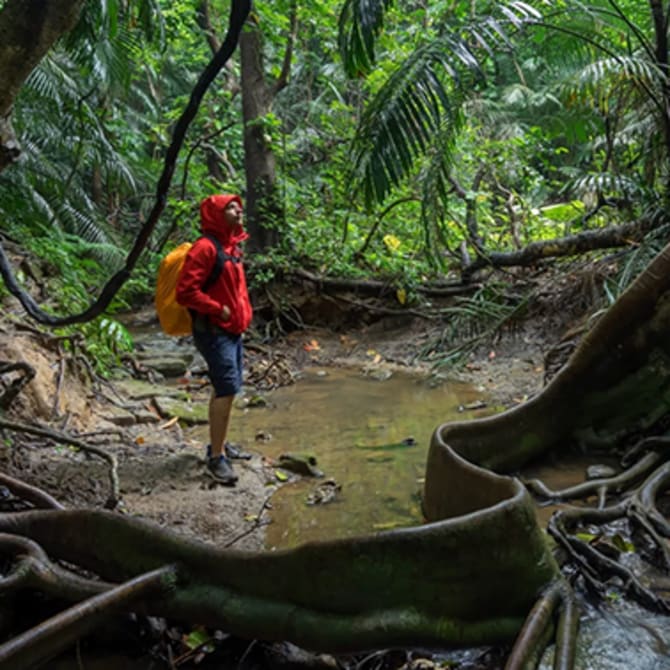
Travel Logs The Shikoku 88 Temple Pilgrimage A 1,200-Year-Old Path into World Agricultural Heritage Sites in the Mountains
Embark on a 5-night, 6-day journey through Shikoku and trek the Shikoku Pilgrimage, a trail of 88 sacred sites revered since ancient times. Delve into the history and significance of this traditional route woven over more than 1200 years. The Shikoku Pilgrimage is more than just a long pilgrimage trail. it's an enriching experience that combines cultural learning and spiritual growth. In the latter part of the tour, you will have the chance to explore Shikoku's natural landscapes, food, and traditional culture. Discover centuries-old sustainable agriculture hidden in the mountains. Witness traditional performing arts like the Awa Odori dance and Bunraku puppetry. Savor unique local cuisine, and enjoy stunning views and outdoor activities. Unwind in relaxing hot springs, and immerse yourself in heartwarming interactions with locals. It is an itinerary filled with enjoyable experiences and insights that will stimulate your intellectual curiosity.
Day 1
On arriving at Tokushima Awaodori Airport, head to central Tokushima by bus or taxi. First, check in to your accommodation in the city, and meet up with your companions sharing this journey.
Afterward, go to a traditional Japanese izakaya pub. Have dinner while mixing with your travel companions and the locals.

Awa Odori Kaikan (Awa Odori Museum)
Next, you will go to the Awa Odori Kaikan, a museum that communicates the beauty of the Awa Odori dance, a traditional performing art of Tokushima Prefecture. You can watch and experience Awa Odori dancing in the museum all year round. Working up a nice sweat with the locals and your travel companions is sure to bring you all closer together.
Your journey on the Shikoku 88 Temple Pilgrimage starts on the following day. Return to the hotel a little early, and get a good night’s sleep to prepare yourself physically.
Day 2
After leaving the hotel, you will embark on your journey along the Shikoku 88 Temple Pilgrimage.This two-day plan will allow you to experience the best of the Shikoku 88 Temple Pilgrimage in moderation, visiting the first six sites in order on the first day, and three sites near the end of the route on the second day, including the final 88th site.
Along with the nine sacred sites in the itinerary, there are many more temples along the pilgrimage route, each with its unique history and characteristics. Consider how you would like to navigate the trail, and how many temples you wish to visit according to your travel plans.

Pilgrims traditionally dress in all-white robes.
Pilgrims wear a three-piece set of white robes, a ‘wagesa’ stole which is a band of colored cloth hung around your neck, and also carry a pilgrim’s staff. The white robes trace their roots back to a time when the Shikoku 88 Temple Pilgrimage was harsher than today, and people put on burial clothes in advance so that they might enter nirvana if they lost their lives along the way.
The wagesa stole is an extremely simplified version of the kesa stoles worn by monks. The staffs which pilgrims carry are an embodiment of Kobo Daishi. They symbolize that you are making the pilgrimage with his protection./p>

Ryozenji Temple.
Board the tour shuttle, and disembark at Ryozenji Temple, the starting point of the Shikoku 88 Temple Pilgrimage.

Hanging lanterns in the main hall of Ryozenji Temple.
At Ryozenji Temple, worship in the main hall with its ceiling covered by intricate hanging lanterns to pray for a peaceful trip. Continuing on, you will visit the second pilgrimage site at Gokurakuji Temple, the third site at Konsenji Temple, and the fourth site at Dainichiji Temple, walking a distance of about 9 kilometers.

Gokurakuji Temple, Chomeisugi.
At Gokurakuji Temple, a major highlight is the Chomeisugi, a Japanese cedar more than 1,200 years old that is said to have been planted by Kobo Daishi himself.

Konsenji Temple.
Konsenji Temple will greet you with its vivid vermillion Niomon temple gate. Legend tells that in the 9th century, Kobo Daishi saw the local villagers suffering from the sun and drought, so he dug a well that fills with sacred water.
After visiting the fourth pilgrimage site at Dainichiji Temple, there will be a lunch break. Board the shuttle, and head to a local favorite restaurant. When you have replenished your energy, you will continue the pilgrimage in the afternoon. Getting back on the shuttle, you will set off for the fifth pilgrimage site at Jizoji Temple.

Dainichiji Temple.
When you arrive, compose your mind before you worship. Next, you will view the inner sanctuary, called the Gohyaku Rakando (“Hall of 500 Arhats”).

Gohyaku Rakando (Hall of 500 Arhats)
The Gohyaku Rakando is a hall lined with brightly painted, life-sized wooden statues of arhats (practitioners who have achieved a notable level of enlightenment), and it is reputedly one of the largest collections in Japan.

Anrakuji Temple.
Next, you will walk a distance of about 5.3 kilometers to Anrakuji Temple, the sixth site and the stopping point for today. After a short break, you will participate in a mystical Buddhist experience for about 30 minutes that includes making fire offerings and floating paper lanterns down a river.

Large communal bath in Anrakuji's shukubo lodge.
Tonight’s accommodation will be the shukubo lodging next to Anrakuji Temple, which has a history stretching back 400 years. Experience the liberating large communal bath, savor a dinner of local Tokushima cuisine, and replenish your spirit for tomorrow's Shikoku pilgrimage.
Day 3
Wake up and leave the shukubo lodgings behind. Your first destination is the Ohenro Koryu Salon, a facility for pilgrims to exchange information and interact with local residents. After receiving advice from the facility administrator, you will set off on the pilgrimage on foot to Okuboji Temple, the last of the 88 pilgrimage sites. On this journey of about 11 kilometers, you can enjoy a rich natural mountain landscape that changes in appearance through the four seasons.

Okuboji Temple.
Upon reaching Okuboji Temple, the final stop on the Shikoku 88 Temple Pilgrimage, take a moment to gather your thoughts before beginning your worship.

Sanuki udon noodles, the local specialty of Kagawa.
Next to the main hall, you can see where they store the staffs and other items of the pilgrims who successfully completed the pilgrimage to all 88 sites.
The training hall beneath the Daishido hall enshrines the main images of all 88 sacred sites, as well as sand gathered from each location. By completing a circuit, Here, even those who cannot visit the 88 pilgrimage sites due to a lack of time or stamina, are able to perform osuna-fumi (“stepping on sacred sand”), which is said to provide the same benefits as completing the Shikoku 88 Temple Pilgrimage.

Okuboji Temple, Hōjō Hall.
After visiting Okuboji Temple, For lunch, savor some Sanuki udon noodles, the local specialty of Kagawa. Skillfully made by hand using Kagawa's fresh ingredients such as wheat and pure water. The noodles are prepared with miso and other ingredients to make a delicious, delightful meal. It's a local delicacy loved by locals and visitors alike, including pilgrims.

Shashingatake.
Next, you will board the shuttle and head for the 73rd pilgrimage site at Shusshakaji Temple. After worship in the inner sanctuary, you will set off for Shashingatake, where legend says that Kukai threw himself from the precipice at the age of seven. The fantastic view of Setouchi spreading out before you is worth the hour-and-a-half trip up and down the steep slope.

Zentsuji Temple.
Getting back on the shuttle, you will go to the 75th pilgrimage site at Zentsuji Temple. This is one of the three major sacred sites of Kobo Daishi scattered across Japan, and it is revered as the birthplace of Kukai.

Two large camphor trees at Zentsuji Temple.
The major highlights in the precincts are a beautiful five-story pagodasoaring overhead, and two large camphor trees said to be well over 1,000 years old that have been designated prefectural natural monuments. You can also experience “kaidan-meguri,” (travelling through a pitch-dark underground passageway about 100m long) as a mental training activity.
After leaving Zentsuji Temple on the shuttle, the next stop is Kotohira Onsen Kotosankaku, your accommodation for the night. Soothe away the weariness of your two-day Shikoku 88 Temple Pilgrimage while you enjoy open-air hot spring baths with a view, and a dinner of kaiseki cuisine.
Day 4
In the latter part of the journey, travel through the nature-rich mountainous regions of Shikoku, visiting landmarks like Mt. Tsurugi and the Iya Valley villages. You will be greeted by locals who have nurtured and continued traditional farming practices, truly embodying the practice of living in harmony with nature.
The next leg of your journey leads you to Sarukai Village, part of the Nishi-Awa area. It is known for its scenery that evokes the original landscapes of Japan, featuring vine bridges and traditional houses. The age-old terraced agriculture in this region is recognized as a vital traditional agroforestry and fisheries practice that will be preserved for future generations. Its ingenuity has earned it a "Globally Important Agricultural Heritage System" by the Food and Agriculture Organization of the United Nations.

Soba fields on a sloping hillside.
Spend an hour strolling through this unique village that has been built on steep slopes, exceeding 25 degrees, and offers a glimpse of the locals' wisdom and lifestyle. After the walk, savor culturally rich dishes made with locally grown ingredients from the terraced fields, and genuinely appreciate the abundant blessings of the land.

Cloud Sea of Mt. Tsurugi,
In the afternoon, you will check in at La Foret Tsurugisan, a lodge located 1,500 meters above sea level on Mt. Tsurugi, the highest peak in Tokushima Prefecture. You will set off on a hike of about two hours to visit the beautiful headwaters of the Sadamitsu River, a tributary of the Yoshino River.
In the evening you will enjoy shabu-shabu made with locally-sourced pork in the dining room at La Foret Tsurugisan. Fall asleep surrounded by the majestic natural landscape of Mt. Tsurugi.
Day 5
On the fifth day, you will depart La Foret Tsurugisan and travel to a secluded region deep in the mountains called Oku-Iya.
Oku-Iya has a majestic natural landscape, including Mt. Tsurugi and the Obokekyo and Kobokekyo gorges. There is a legend that after the downfall of the Heike samurai clan (who once ruled Japan in the 12th century), their descendants fled and found shelter here.

Double Vine Bridge.
The Oku-Iya Double Vine Bridge is woven from wild tara vines that grow in the area, and is composed of two bridges, the 42-meter “Man Bridge” and 22-meter “Woman Bridge,” which are sometimes referred to together as the “Wedded Bridges.” It is said that the Heike clan was the first to build these bridges.
Experience the thrill and historical allure of the Double Vine Bridge, and walk through the valley formed by verdant mountains and rivers.

Kakashi no Sato (Village of Scarecrows)
Next, you will visit Kakashi no Sato (“Village of Scarecrows”) in the Nagoro area of Higashi-Iya. There are more than 350 unique scarecrows created as a hobby by a single female artist. Each scarecrow is displayed as though going about its daily life. All of them have a detailed profile, and you can browse the “Basic Scarecrow Registry” at a rest area near the artist’s home. The population of the village has decreased to the point that the scarecrows outnumber the residents, but the residents welcome the revitalization of the village that the scarecrows have brought.
For lunch, enjoy a meal of soba noodles made with local ingredients at a restaurant run by the farmers of Higashi-Iya. After your meal, listen to local folk songs.

Ochiai Village.
In the afternoon, you will visit Ochiai Village, an area designated as an Important Preservation Districts for Groups of Traditional Buildings. Encounter traditional circular agriculture that is recognized as a globally important agricultural heritage system.

Experience tea leaf picking and green tea brewing.
This unique village was formed from the middle of the Edo Period (1603 – 1868) through to the early Showa Period (1926-1989). The village is built on a steep slope roughly 390 meters high, and is dotted with traditional houses, stone walls, and farm fields. You will take a stroll around the village, and experience tea leaf picking and brewing green tea in a farmer’s garden.
For dinner, enjoy a home cooked meal prepared by the women’s auxiliary of the local chamber of commerce at a restaurant that serves as a tourist information center.

Togenkyo-Iya Mountain Village, Exterior.
Your accommodation for the night will be the Togenkyo-Iya Mountain Village in Ochiai Village. This is a lodging facility produced by the American author Alex Karr. The facility aims to preserve the beautiful scenery and culture of ancient Japan.

Togenkyo-Iya Mountain Village, Interior.
The eight unique traditional thatched-roof houses have been renovated and can be rented as private cottages, allowing you to experience life in a traditional home.
Day 6
In the morning, you will depart Ochiai Village for the Higashi-Iya Soba Dojo. Enjoy the soba noodles, a local specialty of Iya. Before noon, you will also visit the Awa Jurobe Yashiki Theater and Museum.

Awa Ningyo Joruri Puppet Theater.
You will watch Awa Ningyo Joruri Puppet Theater (an important intangible cultural property which developed in the farming villages of Tokushima Prefecture) and take a tour of the museum. There are monitors and panels with multilingual subtitles set up so that guests from overseas can enjoy the performances.
After enjoying traditional performing arts, indulge in a Japanese lunch made from fresh local ingredients. Then, you'll be transported by shuttle bus to Tokushima Airport, allowing you to savor the lingering memories of your journey as it draws to a close.
As you journey through Shikoku, you can engage in the spiritual practice of the Shikoku Pilgrimage, a tradition practiced since ancient times. This experience not only introduces you to the world of Japan's spirituality, but also fosters deep self-reflection and personal growth. Immersing yourself in the countless charms of Shikoku, including its nature, cuisine, culture, and the wisdom of local lifestyles, will enrich your mind and body. By the end of your journey, you will likely carry unforgettable memories that could become new guiding principles in your life.



































































